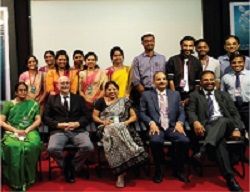Notes from the field: Hospital medicine in India
Last December, speakers from several countries joined their colleagues in Kochi, India, to discuss clinical administrative, and education issues during a multi-day conference.
In December 2014, one of the authors (Dr. Newman) first heard about the possibility of ACP organizing a hospital medicine meeting in India. It seemed like a great concept, but difficult to arrange. However, 12 months later, thanks to the hard work of Dr. Menon and her team at the Amrita Institute, the concept became a reality. Speakers from several sites in the United States, Canada, and Japan joined their colleagues in Kochi, India, to discuss clinical, administrative, and education issues during a multi-day conference on hospital medicine, under the auspices of the ACP India Chapter.
Compared to the United States, there are significantly fewer physicians per capita in India. While American doctor density is 2.5 per 1,000 people, in India it is only 0.7 per 1,000, according to the World Bank. The total expenditure on health care per capita is only $61 (4% of GDP), versus $9,146 (17% of GDP) in the United States (which puts us, by the way, third highest behind Norway and Switzerland). This decreased practice density and lower level of spending present a significant challenge to hospital care. There is a recognized need for greater inpatient expertise to manage the large population of complex patients with a wide variety of comorbidities. There is also a large spectrum of hospitals from very small to very large with a wide variety of practice models. However, only a few facilities have adopted the hospitalist model. Of the current Indian hospitalists, several have practiced in the United States and brought that knowledge back to India. Hospitals such as the Amrita Institute and Columbia Asia Bangalore have pioneered this model.

There are many facilities in India that have adopted high-tech answers to the challenge of managing a large population and disease burden with limited resources, including electronic medical records and telehealth options. But as hospitals face census issues and economic crises, the hospitalist model is very appealing.
As a first step toward building the hospitalist model in India, the First International Symposium of Hospital Medicine in India (ISHMI) was held at the Amrita Institute in December. In addition to on-site faculty, remote faculty participated via the Web. The goals of the conference were to introduce hospital medicine as a novel track of specialization for internists in India; promote quality, safety, and teamwork; and, of course, to review pertinent clinical topics.
There were several unique aspects of this meeting. The first was the preconference meeting. This was a special gathering of various CEOs and administrators from many of the leading hospitals in the country to introduce the concept of hospital medicine and assess the feasibility of establishing this model of care in India. The discussion was quite amazing to those who sat at a table 15 years ago as hospital medicine rolled out in the United States. People asked how it would affect referral patterns, whether there be a voltage drop in care and communication issues, how patients would respond, what the economic effects would be? To quote the great Yogi Berra, it was déjà vu all over again for Dr. Newman, who has observed these concerns to be universal constants of introducing hospital medicine, in the U.S., Brazil, Chile, and now in India.
Another truly novel aspect of this meeting was the high level of interest from government. The keynote was given by the Indian Union Minister of Health and Family Welfare, J.P. Nadda. In his inaugural address, he promised support for the initiation of hospital medicine. Also on the stage were other important members of the Indian medical community, including the ACP Governor for the India Chapter and the executive director of India's National Board of Examinations.
Starting hospital medicine from scratch is a daunting challenge, but as we have seen in many countries around the world, as the model grows, its worth becomes self-evident. In a country where poverty and advanced technology exist side by side and where many resources are scarce, there is no doubt that a unique brand of hospitalist practice will develop. With the support of other hospitalists from around the world, we strongly believe that within a few short years, we will see an explosion of hospitalists in India, surpassing even the amazing expansion that was seen in the U.S. The key elements, the need, and the desire are there. Of course, training programs and education will be essential elements still to develop.
The 130 delegates, including postgraduates, faculty, and internists from all over India, and the representatives from private and academic institutions who were present seemed enthusiastic about this challenge. The seeds of change have been sown; only time will tell what the harvest may be.



